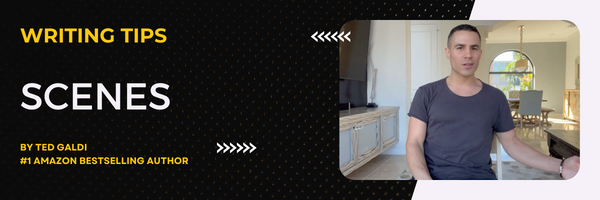How To Write a Great Scene [Examples and Tips]Learn how to write an unforgettable scene in a book, screenplay, or short story. For even more writing advice, download my FREE outlining guide What is a scene?A scene is a unit of a story that focuses on one or more characters involved in a specific conflict. These scene-level conflicts should play roles in the story's overall conflict. For example, a story's overall conflict may involve a hero detective trying to catch a villain murderer. A scene in this story could be built around a conflict the detective gets into with his captain - the detective wants to go outside department guidelines to lure the villain, but the captain pushes back. What makes a good scene?Conflict is the key to a good scene. Every scene should have a subject character wrapped up in a conflict. This conflict typically involves other characters, yet doesn't have to. For instance, a character may be in conflict against nature, struggling to climb a mountain. Other than conflict, here are some characteristics good scenes tend to have:
A scene should advance the plotEven if a scene features a compelling conflict, the scene still needs to tie into the overall story to be effective. It should advance the plot. For example, a scene where two cops are dodging gunfire from a masked man in the woods may be exciting. However, if the scene doesn't move the story's plot forward, it'll feel flimsy and out of place. Thus, before you write scenes, I strongly advise you structure your story into an outline. Once you have an idea of what you want to accomplish in your beginning, middle, and end, coming up with scene concepts becomes simpler. Ask yourself these questions:
Advancing the plot while characterizing in a sceneThough not every scene needs to feature character development, many memorable ones do. As the characters in a scene square off in conflict, certain traits about those characters can emerge. For instance, in the example discussed above - where a detective is arguing with his captain about going against guidelines - the detective would come off as rebellious and daring, while the captain would come off as stubborn and cautious. A highly effective scene conflict will not only move your plot forward, but characterize. Revealing exposition in a scene Often, the audience needs to know a piece of information to follow your plot. This information is known as exposition. What you want to avoid is a data dump, where you pile a bunch of information onto your audience that's necessary to know, but doesn't seem organic to the scene where it appears. Instead, you should try to weave this information into the scene's conflict, either at the center or edge. For example, let' say the audience of a thriller needs to know that a suspect's phone signal was tracked to Houston. Here are two options for getting that information to the audience: (1) Express the information at the center of the scene's conflict. The two police officers at the station receive a call from a tech colleague that the suspect was tracked in Houston. However, in this example, one of the cops isn't satisfied with the information. He starts asking the tech colleague about the specific neighborhood of Houston where the suspect is. The technician says he doesn't have that level of detail. The cop accuses him of being bad at his job. The technician explains the limits to the tracking technology, yet the cop stresses more should still be done. (2) Express the information at the edge of the scene's conflict. Two police officers are at their station. They receive a phone call from a tech colleague that the suspect was tracked in Houston. The cops are excited about this news and head to their car to make the trip to Houston. However, moments after the officers get on the road, a masked man in the woods starts shooting at their car. In the first example, the exposition is at the heart of the scene's drama. In the second example, the scene's drama lies in the shootout, however, the exposition is at least tied to the shootout - the cops are fired at after they act on the expository information. Scenes and their settingsThough scene changes often accompany a change in setting, a single setting can contain multiple consecutive scenes. For example, in a boxing story, a boxing ring may be the setting for various scenes in a row. As long as multiple distinct conflicts occur, multiple scenes can occur. For example, in one scene, a boxer is engaged in a conflict with his trainers in his corner of the ring. After this conflict is resolved, the boxer heads to the center of the ring to fight, engaging in a new conflict with the opposing boxer. In film shoots, the term scene may be used to describe a series of consecutive shots in a single setting, even if those shots don't constitute all the events of a conflict. For example, let's say a movie has a knife fight. An angry character walking up to the bar through the parking lot may be referred to as a scene, with the knife fight inside the bar versus another character referred to as a second scene. However, from a dramatic writing perspective, since both of these actions (walking up to the bar and fighting with knives) refer to the same conflict (one character trying to stab another), we can view these actions as part of one scene. Want more tips for writing a great story?Download my free outlining guide:
0 Comments
Leave a Reply. |


 RSS Feed
RSS Feed